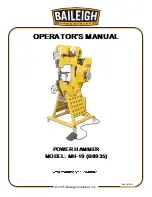
Operating instruction: O003 / 5759
Edition: 04/2019
Reproduction, duplication of this document - even a partial form –
are subject to our permission. All rights reserved.
In this data sheet any liability for changes, errors or misprints is excluded.
8
Never make any modifications, additions or conversions which might affect safety without the sup-
plier´s approval.
Additional mountings or modifications have as consequence that the responsibility for the accord-
ance with the EU-directive has to be assured by the person who carries out the mountings and the
modifications.
Spare parts, only, from the original equipment comply with the technical requirements specified by
the manufacturer and guarantee the failure-free operation of the device.
2.3
Personnel selection and qualification
The device can only be operated by staff accordingly skilled and instructed.
Work on electrical equipment of the device must be performed by a qualified electrician or trained
individuals under the direction and supervision of an electrician according to electro-technical regula-
tions.
2.4
Safety instructions for specific operating phases
The device can only be operated in a safe and absolutely reliable state. Make sure in particular that
all protective and safety-oriented devices are in place and fully functional.
Loosened screws and hose connections must be tightened upon completion of the maintenance and
repair work.
2.5
Mobile devices
In case of minor changes of place, please even disconnect the device from any external power sup-
ply!
Properly reconnect to the mains prior to restarting the device!
Always use hoisting and slinging equipment with sufficient weight bearing capacity for loading!
Position hoisting devices or slinging means only on the load lifting appliances of the device that are
provided for this purpose!
Please take the necessary and appropriate measures for making sure that during the transportation
no device part may fall in or loosen!
2.6
Safety instructions
The removing of covers or parts of safety-oriented components may increase the risk of accident.
Conversions, maintenance and repair work must be performed by trained, competent and skilled
persons.
Because of the risk of burns, make sure the device is always freely accessible and is not covered.
The devices do not have their own protection appliances against electrical overload. For this reason,
the operator must ensure that the electrical installations at the operated place, are protected from
overload.
Regularly inspect/check the electrical equipment of a device. Visible faults, such as loose connections
must be immediately rectified.








































